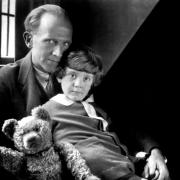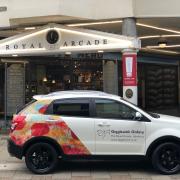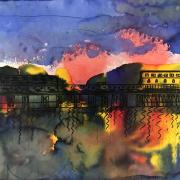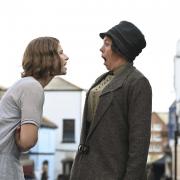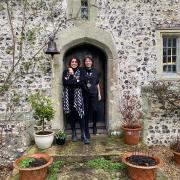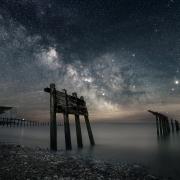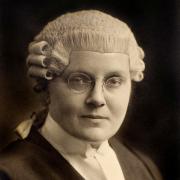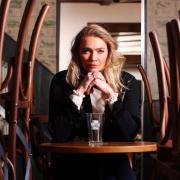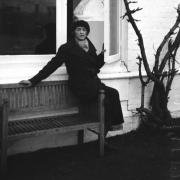The city of Brighton and Hove has a multitude of famous residents. Steve Roberts follows the blue plaque trail to discover some extraordinary life stories
Martha Gunn (1726-1815)
36 East Street
Martha Gunn was the 'queen of dippers', a figurehead of the rising popularity of sea bathing. Martha and her 'bathing women' looked after female visitors to Brighton and ensured they took the waters with all due decorum. They had to be able to operate a bathing machine, which meant manoeuvring the contraption in and out of the sea and then helping the delicate lady take the waters. Martha and her colleagues would have needed to be fairly big and strong.
There is a rhyme claiming that she bathed George III's son and it's said that she was a favourite of the Prince of Wales (the future George IV). There's a painting of the two of them in the tea room of the Royal Pavilion. A pub in Upper Lewes Road bears her name.
As well as living in East Street (in what is today a branch of Patisserie Valerie), Martha is also buried in Brighton, in St Nicholas's churchyard. That's entirely apt, as it's believed she never actually left Brighton in her life.
A picture of Martha Gunn is on display at Brighton Museum & Art Gallery.
George Canning (1770-1827)
Royal Crescent Mansions, Marine Parade
George Canning was my kind of statesman, the only British Prime Minister I know of who fought a duel (in 1809). To be fair, he wasn't PM at the time but nevertheless, it's impressive. As Minister for Foreign Affairs he 'disagreed' with Viscount Castlereagh, the Secretary at War, over their shared brief, and off they trooped with their seconds to Putney Heath.
Canning's earlier indiscretion did not prevent him rising to the highest office, as he became PM in 1827. Sadly, he earned further notoriety by becoming our shortest-lasting premier at just 119 days.
George Canning lived in what is now Royal Crescent Mansions during February 1827, as he forlornly tried to fight off his final illness. So we did have a reigning prime minister living in the city, albeit one who was suffering from headaches, lumbago and inflammation, and only briefly at that. He died in the August.
A bust of George Canning is on display at Brighton Museum & Art Gallery.
David Mocatta (1806-1882)
38-39 Devonshire Place
England's first Jewish architect, David Mocatta remodelled the Brighton Regency Synagogue in Devonshire Place, which was first built in 1824-25, then enlarged by him in 1838. An inscription under the pediment reads "Jews Synagogue A.M. 5598" (the current 2018-19 Hebrew year is 5779, as its calendar traditionally starts at 3761 BC, the time of Creation). Brighton's first purpose-built synagogue, it was replaced by one in Middle Street (1875) and is now apartments.
Mocatta is commemorated by not one but two plaques in Brighton, as he was also appointed architect to the London and Brighton Railway (1839) and therefore came to design the company's Italianate station in Brighton. There is a blue plaque inside the station, which tells us that Mocatta's terminus became operational in September 1841. He also designed a number of other stations in Sussex, including Three Bridges and Haywards Heath.
George Jacob Holyoake (1817-1906)
36 Camelford Street
A social reformer, the founder of Secularism (separation of church and state) and editor of The Reasoner, a Secularist periodical, George Jacob Holyoake was a teacher of mathematics and lecturer on Robert Owen's socialism. He also became secretary of Italian nationalist Giuseppe Garibaldi's British contingent. He was nothing if not interesting.
Most notoriously, the controversial Holyoake was the last man in England to be jailed for atheism and blasphemy (in 1842). How times have changed; there wouldn't be enough prison cells today. He also contributed a few new words to the English language, such as jingoism. He was uncle to the MP and convicted fraudster, Horatio Bottomley (of "Hang the Kaiser" fame). Holyoake was also the first president of the Brighton Equitable Co-operative Society, of which he wrote a history.
Holyoake made Camelford Street his home from 1881 until his death in 1906.
Dion Boucicault (1820-1890)
6 Cavendish Place
An Irish dramatist and actor, Boucicault was famed as one of the best actor-playwrights of his era, with around 150 plays credited to him. He was a favourite of Queen Victoria. He originally gloried in the name Dionysius Lardner Boursiquot. Dionysius was a Greek god who lorded it over wine, fertility, ritual madness, religious ecstasy and - wait for it - theatre.
Given that Boucicault made a name for himself, not only with his theatrics, but with a colourful personal life, this nomenclature seems entirely apposite. His first wife was alleged to have died in a Swiss mountaineering accident. He then eloped with a young actress and married her, but later left her for another young actress whom he also married, creating a bigamous scandal.
Boucicault lived in Cavendish Place for a decade, between 1862 and 1872. The neighbours' net curtains must have been twitching. When he died, around 18 years later, he was a poorly-paid drama teacher in New York City.
Eleanor Marx (1855-1898)
6 Vernon Terrace
Eleanor Marx, the English-born youngest daughter of the German philosopher Karl Marx, lived in Vernon Terrace in Brighton during 1873, when she was in her late teens. She was an independent soul, as shown by her willingness to leave the family home and strike out on her own at such a young age. She became a schoolteacher in Brighton.
Karl Marx was certainly one of the men who helped shape the 20th century. His three-volume Das Kapital provided the inspiration for the Communist revolution in Russia, and everything that followed from it.
Daughter Eleanor was no shrinking violet though and is deserving of recognition in her own right. She was dedicated to the Labour Movement, a gifted orator, and was also a women's rights campaigner. Aptly, the house in Vernon Terrace has a red door.
Eleanor Marx's life ended in tragedy. She discovered that her partner, Edward Aveling, had secretly married another woman and took her own life by taking poison aged 43.
William Friese-Greene (1855-1921)
20 Middle Street
An inventor and cinematographic pioneer, William Friese-Greene had his first successful picture, using celluloid film, shown in public in 1890, the same year that his invention was patented.
What makes Friese-Greene so likeable is the fact that he was a real boffin who made money from his inventions, but then sank his dosh into further inventions, his experiments including 3D and colour cinematography.
He bankrupted himself three times and died almost penniless. He also got himself jailed on one occasion.
Friese-Greene lived not only in Middle Street (where the plaque records that those first, historic experiments occurred), but also at 9 Worcester Villas, Hove, where he lived between 1910 and 1913.
Sir Edward Marshall Hall KC (1858-1927)
30 Old Steine
Edward Marshall Hall, King's Counsel, was known as The Great Defender and participated in many of the famous early 20th century criminal trials. He was born in Brighton in 1858. Despite a less than stellar scholastic career, he shone as a lawyer, where his personality often won through rather than any particular legal brilliance.
It sounds unlikely, but it's true. He was also an MP and was knighted in 1917.
Some of Hall's most famous cases were The Camden Town Murder (1907), the Seddon Poisoning Case (1912), The Green Bicycle Case (1919) and the Russell Divorce (1923). His career was dramatised in a BBC series, Shadow of the Noose.
The plaque confirms, of course, that the great lawyer was born in the house in Old Steine.
Rt Hon Frederick Elwyn-Jones (1909-1989)
17 Lewes Crescent
A Welsh Labour MP and barrister, Frederick Elwyn-Jones became most famous as junior British Counsel at the Nuremberg Trials (1945-1946) when prominent Nazis were prosecuted for World War II war crimes, then as leading prosecutor at the Hamburg trial of Marshal Erich von Manstein, who went to prison for four years. Later, Elwyn-Jones would be the leading prosecutor of the Moors Murderers in 1966. He became Lord Chancellor in the 1970s.
The plaque confirms that Elwyn-Jones lived in Lewes Crescent for the last chunk of his life between 1966 and 1989. There was a famous double-act in residence here as Elwyn-Jones' partner in crime was Pearl (Polly) Binder (1904-1990), the polymath writer, illustrator and sculptor, who had a particular fascination with London's East End and its Pearly Kings and Queens. She died in Brighton just under two months after Elwyn-Jones.
Doreen Valiente (1922-1999)
Tyson Place, Grosvenor Street
The reclusive Doreen Valiente, known as the mother of modern witchcraft, who moved to Brighton in 1956, lived in a block of flats in Tyson Place just off Grosvenor Street, until her death in 1999 aged 77. She was also a poet and author. When her plaque was unveiled in 2013, it was the first in the world dedicated to a witch and apparently the first placed on a UK council block.
Witchcraft had a bit of a bad name because of medieval superstition and grim stories of executions, the last of which was carried out in 1727. It was Valiente and another witch, Gerald Gardner, who did much to dust all this off and make modern witchcraft acceptable in the 20th century (it remained illegal until 1951). Valiente proclaimed herself to be a gentle white witch.
Valiente also worked as a translator at Bletchley Park during World War II, then became a leading figure in the Pagan Front, a campaigning group of witches.
More…
- The influence Worthing had on Oscar Wilde's greatest work - It was 125 years ago that Oscar Wilde came to Sussex. Steve Roberts looks at the influence Worthing had on his greatest work




